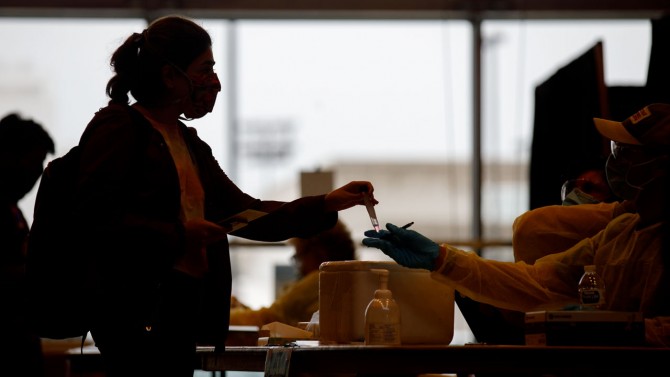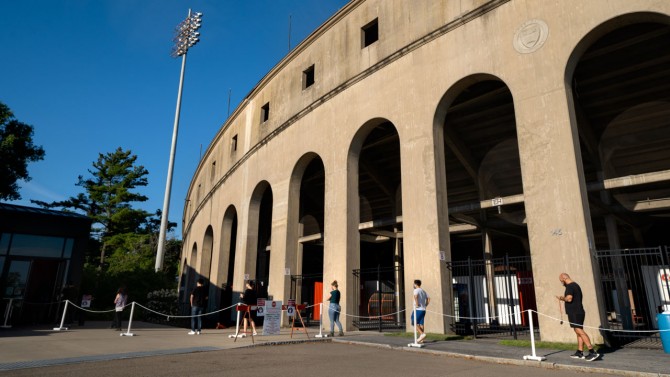
Cayuga Health System personnel administer COVID-19 tests to Cornell students recently at the Fischell Band Center.
With COVID testing off to strong start, Cornell urges vigilance
By James Dean
Early testing shows an extremely low prevalence of COVID-19 within the Cornell community as the university prepares to welcome – and test – thousands of students before a residential fall semester that starts Sept. 2.
The results establish an encouraging baseline for the students’ return while underscoring the importance of following public health guidelines such as wearing masks, practicing physical distancing and limiting social gatherings, said Gary Koretzky, vice provost for academic integration and professor of medicine at Weill Cornell Medicine.
“We’re gratified with how cooperative the community has been in coming to be tested, and we’re really pleased that the prevalence appears very low right now,” Koretzky said. “But we don’t want anybody to be lulled into complacency. We are in the middle of a pandemic and we have to continue our vigilance, both in testing but also in personal protective approaches.”
Koretzky, Provost Michael Kotlikoff and Lorin Warnick, dean of the College of Veterinary Medicine, provided an update on the university’s virus testing program in an Aug. 4 message to faculty and staff.
They reported that tests of 983 faculty and staff in June and of 3,208 local and returning students (mostly graduate students) as of July 31 had returned a total of five positive results – two faculty or staff members, and three students.
Testing is being conducted in partnership with Cayuga Health System and the Tompkins County Health Department, which is responsible for case investigations and contact tracing.
All undergraduate, graduate and professional students, whether living on or off campus, will be tested as part of their arrival in Ithaca. Those testing positive will be placed in isolation and provided appropriate treatment and support.
The start of the semester will mark the start of a comprehensive surveillance testing program that will continue through the fall. Testing as often as twice weekly, for undergraduates, the program is designed to identify and isolate any student – and faculty or staff approved to work on campus – who might be infected but not showing symptoms.
“That is the biggest challenge with this coronavirus,” Koretzky said. “Because the virus can be silent and lurking in individuals that don’t know it, we want to identify those people as early as possible.”
The university expects arrival tests to confirm some asymptomatic infections among the estimated 20,000 returning students, Koretzky said – cases that otherwise might have gone undetected. Students will not be cleared to begin their semester until they receive a negative result.
Over the course of the semester, testing could confirm hundreds of cases, President Martha E. Pollack said in an Aug. 5 message to the Cornell and Ithaca communities. But epidemiological models developed by university experts showed those totals would have been higher had Cornell offered only virtual instruction. In that scenario, many students would have returned to off-campus housing in Ithaca anyway, but the university could not have enforced a comprehensive testing program and behavioral requirements to help protect the community’s public health.
To process the thousands of surveillance tests expected to be conducted each day, the university has established the Cornell COVID-19 Testing Laboratory (CCTL) housed at the College of Veterinary Medicine (CVM). The state-of-the-art lab provides valuable new capacity that should enable rapid turnaround times of less than 24 hours and meet a key program goal of not competing with diagnostic testing needs for Tompkins County and the surrounding region, Koretzky said.
The lab was developed through work led by virologists and diagnosticians in CVM's Animal Health Diagnostic Center, collaborating with Cayuga Health System and with faculty and staff across the Ithaca campus and at Weill Cornell Medicine.
Arrival tests now being conducted by Cayuga Medical Center at the Fischell Band Center adjacent to Schoellkopf Field are using swabs to collect tissue from the nasopharynx, then running a polymerase chain reaction (PCR) to detect nucleic acid molecules unique to the virus.
However, Koretzky, Kotlikoff and Warnick said the university has just achieved “a critical development for convenient, high-volume testing,” validating a less invasive, more comfortable procedure using swabs from the front of the nostril. Participants will be able to collect their own sample under the observation of a trained staff member.
Those testing positive during surveillance testing will undergo a follow-up test to confirm the result. The large volume of tests is expected to produce small numbers of false positives, Koretzky said. The confirmation tests seek to minimize the potential for unwarranted isolations and quarantines.
The frequency of surveillance testing is still being determined as data is collected on baseline prevalence in the community, Koretzky said, but will vary based on how much contact different groups have with others. For example, undergraduates living in residence halls will be tested more often – twice a week – than employees who primarily work remotely. An outbreak might necessitate more testing of particular groups.
“This is not static, and we’re going to have to be flexible, because things may change,” Koretzky said. “We’re trying to do this in an evidence-based way so that we make the best use of the resources that we’ve got.”
In addition to arrival and surveillance tests, the university has asked students, faculty and staff to seek testing “for cause,” meaning when someone experiences COVID-19 symptoms or learns they have been in close contact with a person diagnosed with COVID-19. In those cases, students should contact Cornell Health; faculty and staff should visit the Cayuga Health Sampling Site at the Ithaca Mall. Anyone approved to study and work on campus must complete a Daily Check reporting symptoms and other risk factors before accessing campus facilities.
The university leaders noted that Tompkins County in July reported an increase in positive cases that were linked to social gatherings where mask and social distancing guidelines were not followed, and to out-of-state travel.
While Cornell’s early test results have been reassuring, they said, they are also a reminder that testing is just one element of a broader strategy for combatting spread of the virus. The university has launched a public health campaign to help reinforce behavioral guidelines that all students must agree to abide by in a written compact.
“It was important to understand what our current prevalence was before a lot of students came back, and we’re gratified that it’s so low,” Koretzky said. “It’s clear that most people are being careful, and we want to encourage that to continue. Closely following public health guidelines will be critical to success during the fall semester.”
Media Contact
Get Cornell news delivered right to your inbox.
Subscribe


